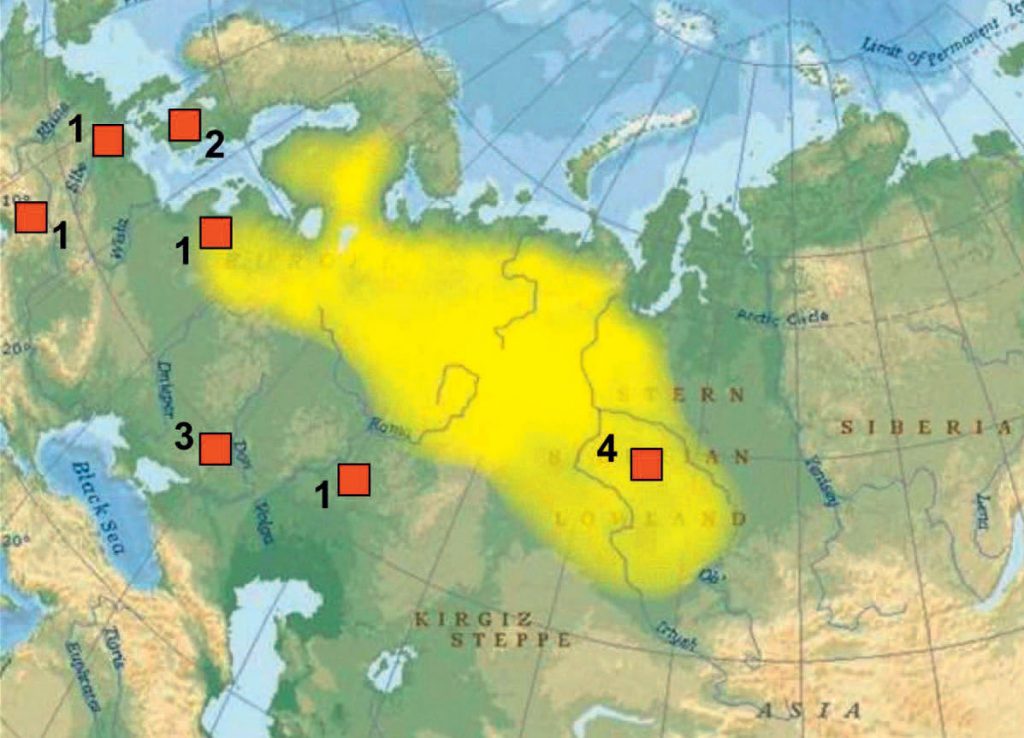A new article (in Russian), Kinship Analysis of Human Remains from the Sargat Mounds, Baraba forest-steppe, Western Siberia, by Pilipenko et al. Археология, этнография и антропология Евразии Том 45 № 4 2017, downloadable at ResearchGate.
Abstract:
We present the results of a paleogenetic analysis of nine individuals from two Early Iron Age mounds in the Baraba forest -teppe, associated with the Sargat culture (fi ve from Pogorelka-2 mound 8, and four from Vengerovo-6 mound 1). Four systems of genetic markers were analyzed: mitochondrial DNA, the polymorphic part of the amelogenin gene, autosomal STR-loci, and those of the Y-chromosome. Complete or partial data, obtained for eight of the nine individuals, were subjected to kinship analysis. No direct relatives of the “parent-child” type were detected. However, the data indicate close paternal and maternal kinship among certain individuals. This was evidently one of the reasons why certain individuals were buried under a single mound. Paternal kinship appears to have been of greater importance. The diversity of mtDNA and Y-chromosome lineages among individuals from one and the same mound suggests that kinship was not the only motive behind burying the deceased people jointly. The presence of very similar, though not identical, variants of the Y chromosome in different burial grounds may indicate the existence of groups such as clans, consisting of paternally related males. Our conclusions need further confi rmation and detailed elaboration. Keywords: Paleogenetics, ancient DNA, kinship analysis, mitochondrial DNA, uniparental genetic markers, STR-loci, Y-chromosome, Baraba forest-steppe, Sargat culture, Early Iron Age.

al., 2009; 3. Krause et al., 2010; 4. this study)”

The Baraba steppe-forest is a region between the Ob and Irtysh rivers (about 800 km from west to east), stretching over 200 km from the taiga zone in the north to the steppes in the south.
The new study brings a more recent picture of the region, from the Iron Age Sargat culture, ca. 500 BC – 500 AD, with five samples of haplogroup N and two samples of haplogroup R1a.
R1a lineages in the region probably derive from the previous expansion of Andronovo and related cultures, which had absorbed North Caspian steppe populations and their Late Indo-European culture.
N subclades prevalent in certain modern Eurasian populations are probably derived from the expansion of the Seima-Turbino phenomenon.
While samples are scarce, Y-DNA data keeps showing the same picture I have spoken about more than once:
N subclades (potentially originally speaking Proto-Yukaghir languages) gradually replacing haplogroup R1a (originally probably speaking Uralic languages), probably through successive founder effects (such as the bottlenecks found in Finland), which left their Uralic culture and ethnolinguistic identification intact.
Therefore, late Corded Ware groups of North-Eastern Europe (in the Forest Zone and the Baltic), mainly of R1a-Z645 subclades, probably never adopted Late Indo-European languages.
Related:
- New preprint papers on Finland’s population history and disease, skin pigmentation in Africa, and genetic variation in Thailand hunter-gatherers
- Another hint at the role of Corded Ware peoples in spreading Uralic languages into north-eastern Europe, found in mtDNA analysis of the Finnish population
- Wiik’s theory about the spread of Uralic into east and central Europe, and the Uralic substrate in Germanic and Balto-Slavic
- New Ukraine Eneolithic sample from late Sredni Stog, near homeland of the Corded Ware culture
- Germanic–Balto-Slavic and Satem (‘Indo-Slavonic’) dialect revisionism by amateur geneticists, or why R1a lineages *must* have spoken Proto-Indo-European
- Something is very wrong with models based on the so-called ‘steppe admixture’ – and archaeologists are catching up